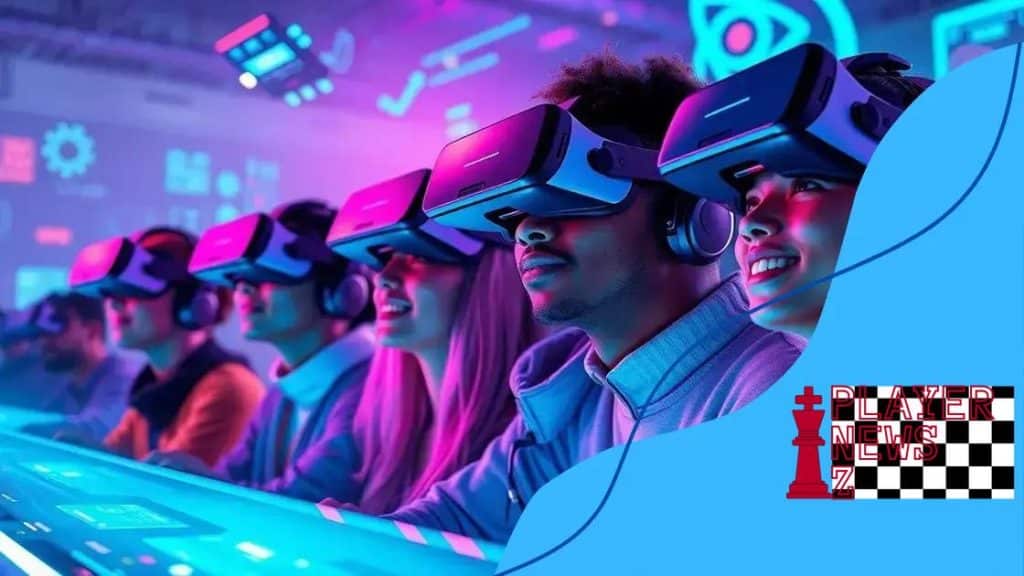The future of multiplayer online games is here

The future of multiplayer online games will be defined by advancements in AI, virtual reality, community-driven content, and increased accessibility, creating more engaging and immersive experiences for players.
The future of multiplayer online games looks bright, with endless possibilities on the horizon. Have you ever wondered how technology will shape gaming interactions? Let’s dive in and explore what’s coming next.
Emerging technologies in multiplayer gaming
Emerging technologies in multiplayer gaming are drastically changing how we connect and play together. With advancements like virtual reality (VR) and augmented reality (AR), gamers can now experience thrilling environments that feel incredibly real.
Virtual Reality Integration
Virtual reality offers players immersive experiences that were previously unimaginable. Players can literally step into a game world, feeling as if they are part of the action. VR headsets enhance the sensory experience, making gameplay more interactive.
Cloud Gaming
Another major development is cloud gaming. This technology allows gamers to play high-quality games without needing powerful hardware. Instead, these games run on remote servers, streamed directly to players’ devices.
- Decreased costs for players
- Access to a wider range of games
- Ability to play on various devices
As these technologies evolve, we can expect even smoother experiences. Imagine playing with friends on a virtual battlefield, all from your living room. The ability to connect and collaborate will only grow stronger.
Artificial Intelligence and Machine Learning
Artificial intelligence (AI) is transforming multiplayer gaming as well. AI can adapt to player behavior, offering personalized challenges and enhancing gameplay. It can create dynamic environments that change based on player choices.
Furthermore, machine learning techniques allow games to understand how players react and adjust accordingly, making every session unique. The future of multiplayer gaming truly lies in these innovations, continuously enriching the player experience.
The role of virtual reality and AR
The role of virtual reality (VR) and augmented reality (AR) in gaming is becoming more significant every day. These technologies enhance how players experience games by immersing them in captivating worlds. Imagine being able to stand in the middle of a battlefield or explore a fantasy land while interacting with your surroundings.
Immersive Gameplay Experience
VR creates a 360-degree environment where actions feel real. Players wear VR headsets that transport them to different worlds. This level of immersion develops a sense of presence that traditional gaming cannot match. You can dodge obstacles, swing swords, and even interact with other players as if they were right next to you.
Augmented Reality Enhancements
AR, on the other hand, overlays digital information onto the real world. This technology allows players to see game elements integrated into their everyday environment. For instance, imagine catching virtual creatures in your local park or solving puzzles scattered around your home.
- Encourages physical interaction with the environment
- Bridges the gap between the digital and physical worlds
- Can be used in educational games for learning
As virtual reality continues to improve, game developers find new ways to utilize these technologies. The possibilities are limitless, from interactive storytelling to cooperative missions with friends across the globe.
With VR and AR, players can experience emotions like never before. The thrill of encountering a fierce dragon or solving mysteries with friends enhances the enjoyment of gaming. These technologies also promote social interaction, allowing players to team up and have fun together, regardless of location.
Community building in online games

Community building in online games plays a vital role in enhancing players’ experiences. When gamers connect with one another, they create lasting friendships that extend beyond the game itself. These interactions can lead to vibrant communities where players support each other and share their achievements.
Creating Connections
Online games often provide platforms for players to chat and strategize together. This constant communication fosters a sense of belonging. Players feel more engaged when they can discuss their strategies, victories, and challenges with others. Whether through in-game chat, forums, or social media, these connections are essential.
Events and Challenges
Many games introduce special events and challenges that encourage teamwork. These events can range from limited-time quests to competitive tournaments. Participating in these activities enables players to work together, further strengthening community bonds.
- Collaborative gameplay enhances friendships.
- Players learn from each other’s tactics.
- Competitive events can build excitement and engagement.
The sense of community becomes even stronger with the development of guilds or clans. Players can join or form these groups, allowing them to team up for missions or events. Within these organizations, members can share resources, knowledge, and support each other in achieving their goals.
Moreover, influencing game development through community feedback is significant. Player input often shapes game updates and helps create content that resonates with the community. This feedback loop empowers players, making them feel valued and heard.
Monetization trends and player engagement
Monetization trends in multiplayer online games are evolving, significantly impacting player engagement. As developers seek sustainable revenue models, they must balance monetization strategies with players’ desires for fair play and enjoyment. Microtransactions have become a popular choice in many games. These allow players to purchase in-game items, skins, or boosts for a nominal fee. This practice helps developers earn revenue while providing players with customization options.
Subscription Models
Another growing trend is the subscription model. Players pay a monthly fee to access a game or special content. This model ensures dedicated funding for developers and offers players ongoing enjoyment. Many players appreciate the additional content and services they receive in return.
Battle Pass Systems
Battle Pass systems are also gaining popularity. They reward players for playing the game by offering exclusive content throughout a season. By engaging with the game more, players can unlock special rewards and enhance their experience.
- Encourages regular play and participation
- Creates a sense of achievement
- Promotes community interaction through shared goals
In addition to these trends, developers increasingly emphasize player engagement. Keeping players interested is crucial for the long-term health of a game. Regular updates, events, and community engagement efforts can help achieve this. Listening to player feedback is also essential in building trust and loyalty.
Overall, the landscape of monetization and player engagement continues to shift. Developers must adapt to these trends to ensure their games remain fun and rewarding. Balancing strategic monetization with a focus on player satisfaction can lead to thriving gaming communities and sustained success.
Future predictions for multiplayer gaming
Future predictions for multiplayer gaming suggest an exciting evolution. As technology advances, the experiences we have in online games are likely to change dramatically. Innovations in connectivity and game design will enhance how players interact with each other and the game world.
Increased Accessibility
One prediction is that multiplayer games will become more accessible. Improvements in internet infrastructure will allow more players from various regions to join seamlessly. This increased accessibility means larger communities and more diverse player interactions.
Integration of AI
Moreover, the integration of artificial intelligence (AI) will transform gameplay. AI could create smarter non-player characters (NPCs) that adapt to player behavior, providing unique challenges and experiences. Players might face opponents that learn and evolve, requiring new strategies.
- Dynamic game environments based on player actions
- Personalized experiences tailored to individual play styles
- More engaging storylines influenced by player choices
Furthermore, virtual reality (VR) and augmented reality (AR) are predicted to play significant roles in the future of multiplayer gaming. As these technologies become more mainstream, they promise to offer immersive experiences that feel real, drawing players into the action like never before.
Lastly, community-driven content is set to rise. Players will have more opportunities to contribute to game development. This shift could lead to unique gameplay elements created by the community, fostering a sense of ownership among players. Participating in shaping the game enhances engagement and investment in the multiplayer experience.
FAQ – Frequently Asked Questions about the Future of Multiplayer Gaming
How will AI change multiplayer gaming?
AI will make games more engaging by creating smarter NPCs that learn from player actions and adapt to their strategies.
What role will virtual reality play in future games?
Virtual reality will provide immersive experiences, allowing players to engage with game worlds in a more realistic way.
How can communities shape the gaming experience?
Players can influence game development through feedback and suggestions, leading to more personalized and engaging content.
What trends are making gaming more accessible?
Improvements in internet infrastructure and cross-platform gaming will allow more players to join and enjoy multiplayer experiences.





